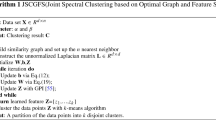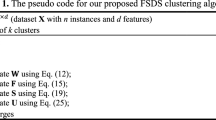Abstract
Traditional clustering algorithms have some limitations, which are sensitive to noise and mostly applicable to convex data sets. To solve these problems, the paper proposes a novel algorithm combining spectral clustering with feature selection. Specifically, the loss item is marked with a root that can reduce the deviation value then improve the robustness of the model. And in the algorithm optimization, there is one parameter is represented by other known parameters, which can reduce the time of parameter adjustment. Then, the regular term \({{\ell }_{2,p}}\text {-norm}\) is applied to reduce the influence of noise and redundant features and prevent the model from overfitting. Finally, Laplace matrix is constructed by kNN algorithm which is used to learn subspace and to preserve the local structure among samples, and the data after dimension reduction is used to spectral clustering. Experimental analysis on 10 benchmark datasets show that the proposed algorithm is more outperformed than the algorithms of the state-of-the-art.

Similar content being viewed by others
References
Chaudhari S, Cabric D (2017) Unsupervised frequency clustering algorithm for null space estimation in wideband spectrum sharing networks. In: 2017 IEEE global conference on signal and information processing, pp 224–228
Elhamifar E, Vidal R (2013) Sparse subspace clustering: algorithm, theory, and applications. IEEE Trans Pattern Anal Mach Intell 35(11):2765–2781
Gao L, Li X, Song J, Shen HT (2019) Hierarchical LSTMS with adaptive attention for visual captioning. IEEE Trans Pattern Anal Mach Intell
Guo G, Wang H, Bell D, Bi Y, Greer K (2003) Knn model-based approach in classification. In: OTM confederated international conferences “on the move to meaningful internet systems”, pp 986–996
Guo Y, Wu Z, Shen D (2019) Learning longitudinal classification-regression model for infant hippocampus segmentation. Neurocomputing
Hand DJ (2007) Principles of data mining. Drug Saf 30(7):621–622
Hao S, Zhou Y, Guo Y (2020) A brief survey on semantic segmentation with deep learning. Neurocomputing
Hartigan JA, Wong MA (1979) Algorithm as 136: a k-means clustering algorithm. J R Stat Soc Ser C (Applied Statistics) 28(1):100–108
Hou C, Nie F, Li X, Yi D, Wu Y (2013) Joint embedding learning and sparse regression: a framework for unsupervised feature selection. IEEE Trans Cybern 44(6):793–804
Hu R, Zhu X, Zhu Y, Gan J (2019) Robust SVM with adaptive graph learning. World Wide Web. https://doi.org/10.1007/s11280-019-00766-x
Huang D, Wang CD, Wu J, Lai JH, Kwoh CK (2019) Ultra-scalable spectral clustering and ensemble clustering. IEEE Trans Knowl Data Eng
Jain AK, Murty MN, Flynn PJ (1999) Data clustering:a review. ACM Comput Surv 31(3):264–323
Ji Y, Zhan Y, Yang Y, Xu X, Shen F, Shen HT (2019) A context knowledge map guided coarse-to-fine action recognition. IEEE Trans Image Process
Jia H, Ding S, Ma H, Xing W (2014) Spectral clustering with neighborhood attribute reduction based on information entropy. J Comput 9(6):1316–1324
Jia H, Ding S, Xu X, Nie R (2014) The latest research progress on spectral clustering. Neural Comput Appl 24(7–8):1477–1486
Kannan SR, Sathya A, Sathya A, Sathya A (2011) Robust kernel FCM in segmentation of breast medical images. Expert Syst Appl Int J 38(4):4382–4389
Li W, Godzik A (2006) Cd-hit: a fast program for clustering and comparing large sets of protein or nucleotide sequences. Bioinformatics 22(13):1658–1659
Li Z, Zhang Z, Qin J, Zhang Z, Shao L (2019) Discriminative fisher embedding dictionary learning algorithm for object recognition. IEEE Trans Neural Netw Learn Syst
Liu Y, Jiao L, Shang F (2013) An efficient matrix factorization based low-rank representation for subspace clustering. Pattern Recognit 46(1):284–292
Lucinska M (2014) A spectral clustering algorithm based on eigenvector localization. In: International conference on artificial intelligence and soft computing. Springer, Berlin, pp 749–759
Malik J, Belongie S, Leung T, Shi J (2001) Contour and texture analysis for image segmentation. Int J Comput Vis 43(1):7–27
Nie F, Wang CL, Li X (2019) K-multiple-means: a multiple-means clustering method with specified k clusters. In: Proceedings of the 25th ACM SIGKDD international conference on knowledge discovery and data mining, pp 959–967
Nie F, Wang X, Jordan MI, Huang H (2016) The constrained laplacian rank algorithm for graph-based clustering. In: Proceedings of the thirtieth conference on artificial intelligence, pp 1969–1976
Nie F, Zhang R, Li X (2017) A generalized power iteration method for solving quadratic problem on the stiefel manifold. Sci China Inf Sci 60(11):112101
Shen HT, Liu L, Yang Y, Xu X, Huang Z, Shen F, Hong R (2020) Exploiting subspace relation in semantic labels for cross-modal hashing. IEEE Trans Knowl Data Eng
Shi J, Malik J (2000) Normalized cuts and image segmentation. IEEE Trans Pattern Anal Mach Intell 22(8):888–905
Tremblay N, Puy G, Gribonval R, Vandergheynst P (2016) Compressive spectral clustering. In: International conference on machine learning, pp 1002–1011
Wang B, Yang Y, Xu X, Hanjalic A, Shen HT (2017) Adversarial cross-modal retrieval. In: Proceedings of the 25th ACM international conference on multimedia, pp 154–162
Weiss Y (1999) Segmentation using eigenvectors: a unifying view. In: Proceedings of the seventh IEEE international conference on computer vision, vol 2. IEEE, pp 975–982
Xie G, Zhang Z, Liu L, Zhu F, Zhang X, Shao L, Li X (2019) SRSC: selective, robust, and supervised constrained feature representation for image classification. IEEE Trans Neural Netw Learn Syst (2019)
Yang Y, Duan Y, Wang X, Huang Z, Xie N, Shen HT (2018) Hierarchical multi-clue modelling for poi popularity prediction with heterogeneous tourist information. IEEE Trans Knowl Data Eng 31(4):757–768
Yang Y, Ma Z, Yang Y, Nie F, Shen HT (2014) Multitask spectral clustering by exploring intertask correlation. IEEE Trans Cybern 45(5):1083–1094
Yang Y, Rutayisire T, Lin C, Li T, Teng F (2013) An improved cop-kmeans clustering for solving constraint violation based on mapreduce framework. Fundam Inform 126(4):301–318
Yang Y, Shen HT, Ma Z, Huang Z, Zhou X (2011) L2, 1 norm regularized discriminative feature selection for unsupervised learning. In: Proceedings of the 22nd international joint conference on artificial intelligence, pp 1589–1594
Zhang J, Yu J, Wan J, Zeng Z (2015) L2, 1 norm regularized fisher criterion for optimal feature selection. Neurocomputing 166:455–463
Zhang Y, Jin J, Qing X, Wang B, Wang X (2012) Lasso based stimulus frequency recognition model for ssvep bcis. Biomed Signal Process Control 7(2):104–111
Zhang Y, Zhao Q, Jin J, Wang X, Cichocki A (2012) A novel BCI based on erp components sensitive to configural processing of human faces. J Neural Eng 9(2):26018
Zhang Z, Lai Z, Huang Z, Wong WK, Xie GS, Liu L, Shao L (2019) Scalable supervised asymmetric hashing with semantic and latent factor embedding. IEEE Trans Image Process 28(10):4803–4818
Zhang Z, Liu L, Shen F, Shen HT, Shao L (2018) Binary multi-view clustering. IEEE Trans Pattern Anal Mach Intell 41(7):1774–1782
Zhou Y, Tian L, Zhu C, Jin X, Sun Y (2019) Video coding optimization for virtual reality 360-degree source. IEEE J Sel Topi Signal Process
Zhu X, Gan J, Lu G, Li J, Zhang S (2019) Spectral clustering via half-quadratic optimization. World Wide Web, pp 1–20
Zhu X, Yang J, Zhang C, Zhang S (2019) Efficient utilization of missing data in cost-sensitive learning. IEEE Trans Knowl Data Eng. https://doi.org/10.1109/TKDE.2019.2956530
Zhu X, Zhang S, Zhu Y, Zheng W (2020) Self-weighted multi-view fuzzy clustering. In: ACM transactions on knowledge discovery from data (TKDD)
Zhu X, Zhu Y, Zheng W (2019) Spectral rotation for deep one-step clustering. Pattern Recognit. https://doi.org/10.1016/j.patcog.2019.107175
Acknowledgements
This work is partially supported by the China Key Research Program (Grant No. 2016YFB1000905); the Key Program of the National Natural Science Foundation of China (Grant No. 61836016); the Natural Science Foundation of China (Grants Nos. 61876046, 61573270, 81701780, 61672177 and 61972177); the Project of Guangxi Science and Technology (GuiKeAD17195062); the Guangxi Natural Science Foundation (Grant No. 2017GXNSFBA198221); the Guangxi Collaborative Innovation Center of Multi-Source Information Integration and Intelligent Processing; the Guangxi High Institutions Program of Introducing 100 High-Level Overseas Talents; the Research Fund of Guangxi Key Lab of Multisource Information Mining & Security (18-A-01-01); and 2019 basic scientific research capability enhancement project for middle-aged teachers in guangxi university (2019KY0062); Innovation Project of Guangxi Graduate Education (YCBZ2020038, JGY2020026).
Author information
Authors and Affiliations
Corresponding author
Additional information
Publisher's Note
Springer Nature remains neutral with regard to jurisdictional claims in published maps and institutional affiliations.
Rights and permissions
About this article
Cite this article
Luo, Q., Wen, G., Zhang, L. et al. An Efficient Algorithm Combining Spectral Clustering with Feature Selection. Neural Process Lett 52, 1913–1925 (2020). https://doi.org/10.1007/s11063-020-10297-6
Published:
Issue Date:
DOI: https://doi.org/10.1007/s11063-020-10297-6




